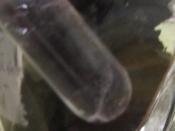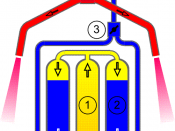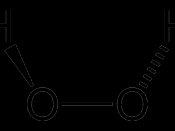Planning
The aim for my experiment is to investigate how a small piece of potato affects the rate of reaction with hydrogen peroxide.
For this investigation the following could be changed could changed:
÷Concentration or hydrogen peroxide
÷Surface area of potato
÷Temperature
÷Mass of potato
÷Catalyst
The following could be measure and observed:
÷Time
÷Size of Potato
I am going to be changing the concentration of hydrogen peroxide. The volume will be 30ml so water will need to be added to make it a fair test. I will do this by measuring the amount of hydrogen peroxide needed, and how much water I will need to make it up to 30ml.
I will do 6 different measurements of hydrogen peroxide to give me enough point to plot on the graph. I will repeat the experiment twice and get the averages, so I know that it is reliable.
The measurement/observation that will be used is time.
I will use a stopwatch to see how long the reaction takes. I will start the stopwatch as soon as the potato is put into the hydrogen peroxide and water and stop it as soon as the reaction stops.
For this investigation the following will be kept the same:
÷Size of potato. This is so the test can be fair. The size of the potato will be 3cm and I will measure it to make sure.
÷Temperature. This will be kept at room temperature.
My prediction:
When the concentration of hydrogen peroxide increases, I think the rate of reaction will get faster, which means the time will decrease.
This is because the more hydrogen peroxide molecules there are, the more chance it has to collide with the catalyse from the potato.
Results
1 2 3
H 0WaterTimeH 0WaterTimeH 0WaterTime
525171525197525195
102013910201491020135
151511715151321515128
20109120101132010109
255662557325571
300543005830056
Average Results
H 0WaterTime
525187
1020141
1515125.6
2010104.3
25570
30056
I repeated the experiment twice, and got the average results. I will now plot these points on a graph.
Evaluation
When the concentration of hydrogen peroxide increased, what happened to the time was it decreased, because the rate of reaction got faster.
This happened because there were more particles of hydrogen peroxide to collide with the catalyst, which meant they had more energy, and speeded up the rate of reaction. This states that my prediction was correct.
There were one or two anomalous readings. You can see this quite clearly on the graph. The unusual readings were for the reaction with 15ml and 20ml of hydrogen peroxide. This may be because the gas managed to escape causing the reaction to slow down.
To improve the experiment, I could measure the amount of hydrogen peroxide more accurately to ensure it is a fair test. I could also do more repeats of the experiment to get better averages.
Another experiment I could do next is to see what affect the surface area of potato has on the rate of reaction


